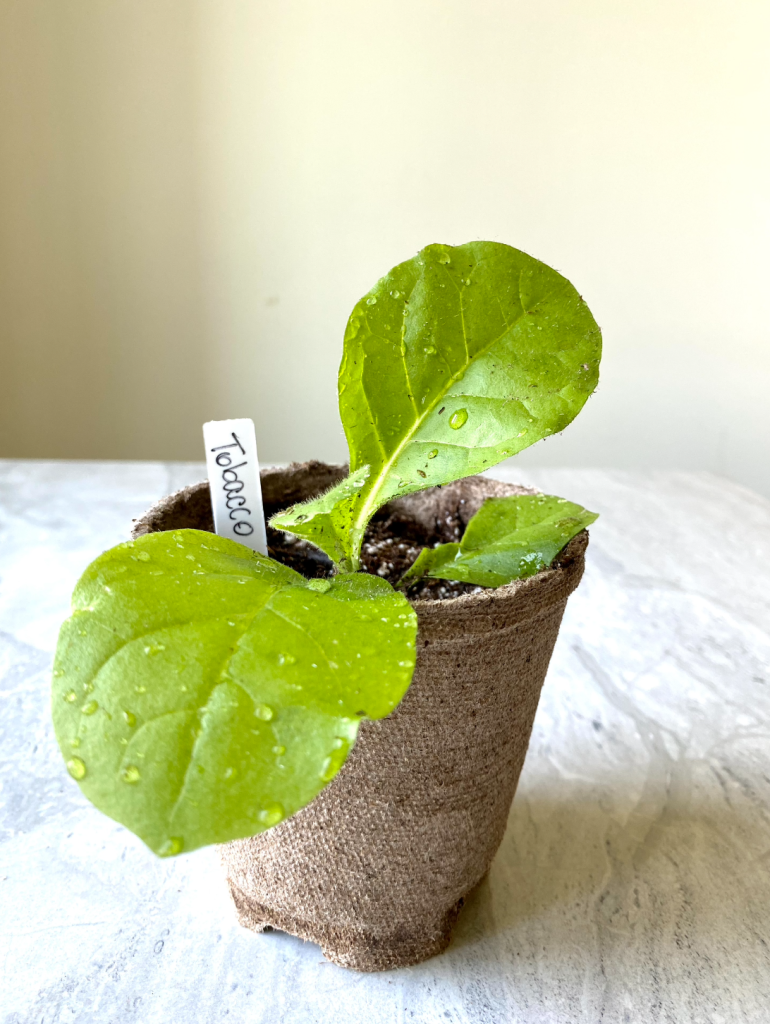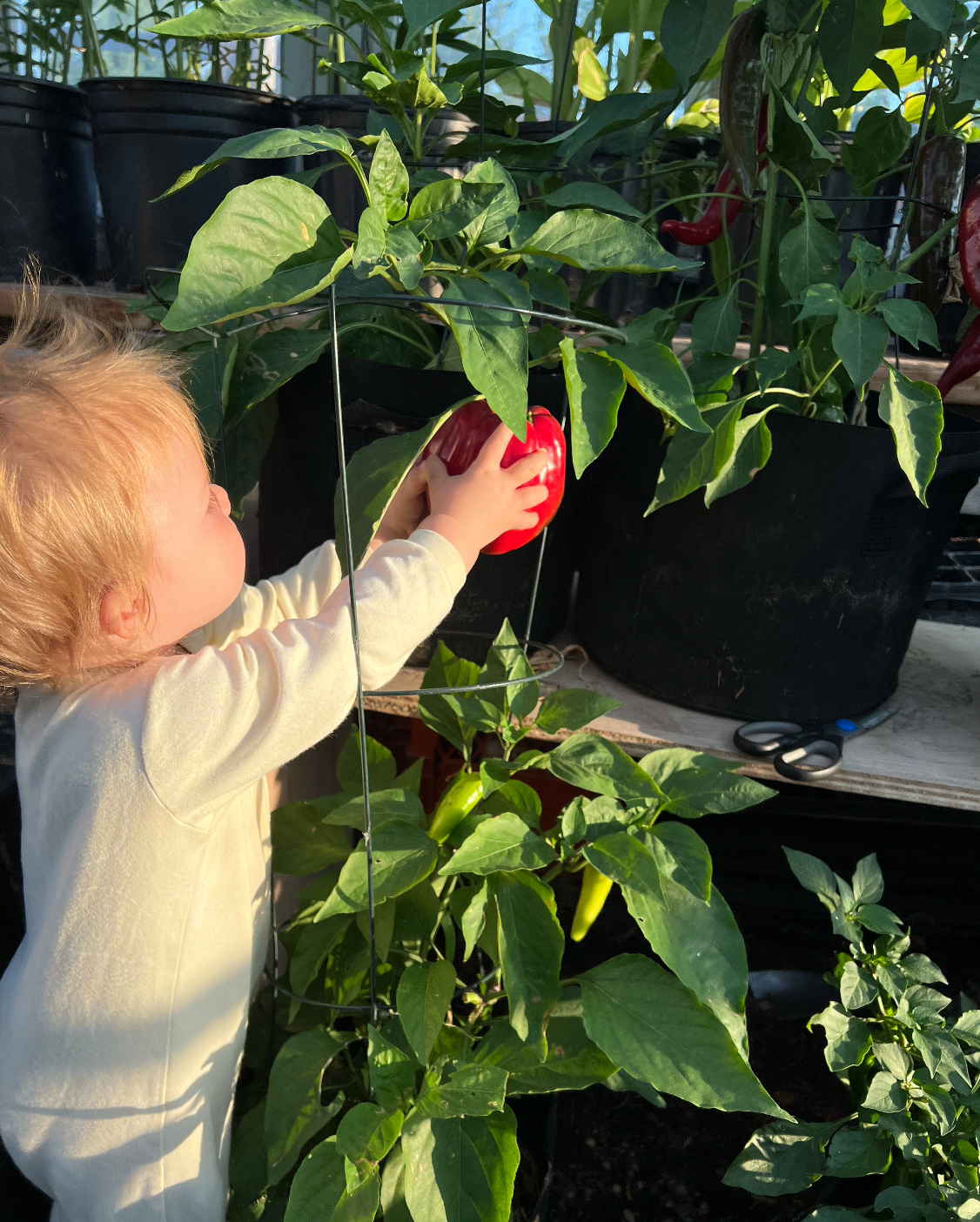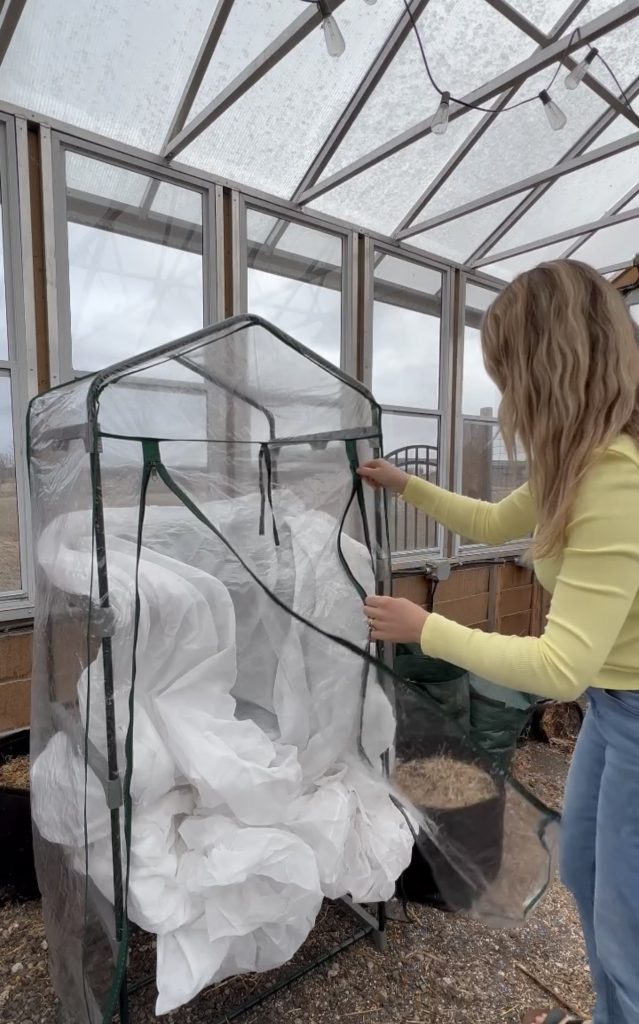10 Plants That Thrive In A Zone 3 Backyard Greenhouse

It’s not uncommon for cold climate gardeners to want their own backyard greenhouse. There’s a certain lust for a warm, little space that will extend your growing season even further. I certainly felt that way! And have to say, a backyard greenhouse definitely does live up to the hype. However, it does come with some learning hurtles too.
The hard truth is….
Just because certain plants do well in your Northern outdoor garden won’t necessarily mean they’ll do well in your greenhouse too.
And that kinda sucks. Especially if you’ve mastered growing a few of your favourite varieties.
On the flip side, it does mean that a backyard greenhouse will give you space to grow new edibles and flowers you haven’t tried yet.
So while there is a learning curve to greenhouse growing, it comes with plenty of rewards!
Don’t have a greenhouse yet but want to build one?
I’ve got a blog for that!
Be sure to give my post Best Tips For Building A DIY Backyard Greenhouse For Cold Weather Climates a read.

Want a backyard greenhouse but don’t want to build it yourself? I can help too!
If you’re looking for the best high quality greenhouse to buy here in Canada, let me suggest Planta Greenhouses Canada.
Planta Greenhouses offer a range of heavy-duty greenhouses that are weather resistant to harsh Canadian Winters and come with a 10+ year warranty!

I know many Canadian gardeners who own a Planta Greenhouse and are thrilled with the quality of the galvanized steel frame and 6 mm double-wall polycarbonate panels.
You can choose from one of many greenhouse sizes, including;
- The Sungrow 26ft
- The Sungrow Urban (smaller backyard model)
- The Alpine models (designed for commercial gardening)
Alright, now let’s get to the good stuff!
Here’s the 10 plants to grow in a backyard greenhouse in Canada and other cold climates.
10 Plants That Thrive In A Zone 3 Backyard Greenhouse

10. Tropical Fruit, Veggies, Flowers & Herbs
It took me a few years of greenhouse growing before I came to this realization:
Most tropical fruits, flowers and herbs will thrive in a Northern greenhouse.
This is because the greenhouse provides an environment similar to their native climate.
When I type this out, it seems like a no brainer. But it took me awhile to actually try growing tropical plants in my Zone 3 greenhouse.
A few tropical plants that have thrived in our greenhouse:
- Ginger — I’ve got a full growing guide on ginger linked here!
- Turmeric — same with turmeric, full growing guide here!
- Lemongrass
- Passion Flowers
- Sweet Potatoes


I have heard of other Canadian gardeners having success growing Mediterranean fruits in their backyard greenhouse. Things like lemons, olives and figs!
This is just a few of the many examples of tropical plants you could try growing in a cold climate greenhouse.
Other tropical plants to experiment growing in a Zone 3-5 greenhouse:
- Paw Paw Trees
- Kiwis
- Gogi Berries
- Houseplants
- Pineapples
*Note: For some of these plants you’d have to overwinter them indoors, bringing them inside from your greenhouse between Nov-March.
To sum it all up, think of your greenhouse as a few Zones warmer than where you live. Don’t be afraid to give something more unusual a try!
9. Tobacco & Cannabis

Two unique things you have maybe not considered growing in a backyard greenhouse!
Tobacco and cannabis. Surprisingly both do very well even in Zone 3.
I have grown tobacco both in my garden and greenhouse.
The tobacco we grew in the garden got stunted at about 4ft. But when we planted it in our raised bed in the greenhouse, it grew +6ft tall!

One thing I find with growing tobacco in a greenhouse is that it does not produce as many flowers. Likely because there are no pollinators.
Regardless, it’s the leaves of the plant that you harvest to dry and smoke. So no flowers is not really an issue!
For greenhouse growing, I would definitely recommend growing tobacco in a large container or raised bed.
We had good success using these 5 gallon fabric grow bags, linked here on my Amazon Storefront.

Now when it comes to growing cannabis, I have actually yet to grow any in my own greenhouse.
This is because here in Manitoba the province only recently made it legal.
In June 2024 the province amended The Liquor, Gaming and Cannabis Control Act now allowing a person over 19 to grow up to 4 cannabis plants per household.
The federal law states the same.
Prior to this change, Manitobans could only grow at home if we applied to the Access to Cannabis for Medical Purposes Program.
The few gardeners I do know who grew cannabis at home during this time had a ton of success in our Zone 3 climate.
Starting cannabis seeds indoors in early Spring is key for success.
Then transfer them out to yout greenhouse for the remained of the growing season.
All in all, if you’re considering growing cannabis in your backyard greenhouse be sure to follow the correct regulations for your State, Province or Country.
8. Hot & Bell Peppers

I can confidently tell you that both hot peppers and bell peppers do well when grown in a greenhouse.
Further to that, my peppers always thrive when I grow them in a container or raised bed compared to in the ground.
And there is some science behind this….
More of which I cover in my growing guide How To Grow Great Hot & Bell Peppers In A Short Growing Season.
What to consider when growing hot peppers in a greenhouse
First, be sure your plants are being consistently watered and fertilized.
I like to fertilize my peppers every 4-6 weeks with both a liquid organic fertilizer and by top dressing with compost.
Highly recommend trying Sea Magic Kelp Fertilizer.

It’s my go-to, affordable and highly effective. I find my plants produce way more fruit when watered with Sea Magic.
Second, try choosing hot pepper varieties that mature in 100 days or less.
This will ensure your plants have produced fruit before the number of daylight hours decreases in the Fall.
A few of my fav hot pepper varieties for Zone 3
- Hungarian Hot Wax: compact plants, fruits are ready by end of July and great for pickling
- Ghost Chilli: as hot as they come, so fun to grow but not ready to harvest until the end of the season
- Spicy Slice Jalapeño: my go-to jalapeño variety as it’s ready to harvest in just 60 days
7. Eggplants

If you’ve grown eggplants before, you may hate them as a veggie crop.
For most Northern gardeners, myself included, eggplants tend to produce very few fruits per plant. So frustrating!
But I have found that growing my eggplants in the greenhouse changes that! Plus growing them in a container increase their yields even more.
Similar to hot peppers, eggplants do better in a restricted space. Again, I love using these fabric grow bags.

Eggplants grown in a greenhouse benefit from consistent watering and fertilizing.
Plus, try using straw mulch to help with water retention. This is a game changer in my greenhouse! It reduces watering significantly.

You can find my preferred brand of straw mulch, GardenStraw here on Amazon Canada.
But the most important key to success when growing eggplant in a greenhouse..
Is to choose a parthenocarpic (seedless) variety.
This will ensure your eggplant does not require pollination.
Of course, there aren’t many pollinators in a greenhouse. Aside from the odd one that flies in. So always choose parthenocarpic or greenhouse-specific varieties.
6. Cucumbers

Cucumbers are a great addition to a Zone 2-4 backyard greenhouse.
I love growing my greenhouse cucumbers vertically up heavy-duty netting like this one.

Like eggplants, it’s best to choose a greenhouse-specific cucumber varietie. These are usually either parthenocarpic or hybrid seeds.
A few greenhouse cucumber varieties I really love
- Anya — European-style pickling cuke that produces in just 50 days
- Vista — Long, salad cucumber
- Lebanese Beit Alpha — slender cucumber that is really easy to grow
5. Tomatoes


It likely comes as no surprise that tomatoes thrive in a Zone 3 greenhouse.
In cold climates, tomatoes love the consistent heat of a backyard greenhouse.
This can be really helpful for Northern gardeners when nighttime temperatures are dipping in the Summer.
Tomatoes require consistent temperatures around 21°C in order to ripen. So a greenhouse can come in handy!
Because tomatoes are self pollinating, I don’t necessarily find you need to grow a greenhouse-specific variety.
I’ve experimented with growing tons of different tomato varieties in my greenhouse. And have mostly had success!
I find Roma tomatoes actually do really well in a greenhouse. They seem less susceptible to disease.

Pro tip: Choose indeterminate tomato varieties for a greenhouse setting. They will do better in containers or compacted raised beds.
Just like other fruiting plants, greenhouse tomatoes need regular watering and fertilizing in order to produce abundantly.
4. Basil

Basil is a heat-loving herb that thrives in a warm greenhouse environment.
What I love about growing basil in my greenhouse is that it can live there from Spring until Fall.
There’s no need to move basil plants outdoors if you don’t want to!
But you do need to be cautious about how much sun your basil is getting in your greenhouse.
While basil loves heat, it has a tendency to bolt and flower if it has too much direct sunlight.
This most often happens in August here in my Zone 3 garden.
But two things that I’ve found help when growing it in the greenhouse.
First, I tuck it around the base of my tomato plants. The tomato foliage provides some shade for the basil.
Second, I install a shade cloth in the greenhouse in mid-July.
This helps keep all my plants cool. But benefits basil too!

Planta Greenhouses carries this awesome shade cloth that is really heavy-duty and durable.
Some of my fav basil varieties for greenhouse growing
- Lettuce Leaf Basil — massive leaves!
- Siam Queen Thai Basil — fantastic for cooking
- Dolly Basil — traditional-style of Italian basil, really easy to grow
3. Brassicas

Cabbage, broccoli and cauliflower might not be the first veggies to come to mind when you think of gardening in a greenhouse.
But they and any other plants in the brassica family do great in a greenhouse in the Spring, Fall or early Winter.
There’s a few ways you can go about growing brassicas in a backyard greenhouse
One idea, and what I like to do, is to start all my brassica seedlings under grow lights in my greenhouse in March-April.

Brassicas thrive in cooler temperatures. And so an unheated Northern greenhouse is a great place for them.
From there, you could transplant your seedlings into a larger bed in the greenhouse. Ideally, you would harvest before the temperatures spike. Otherwise your brassicas will bolt and flower.
Alternatively you could move them outdoors and protect with a heavy-weight row cover or low poly tunnel.
Either way, starting brassicas in a Northern greenhouse in early Spring works really well.
Then come early Fall, you can start again with another tray of brassica seedlings!
Brassicas have grown happily in my greenhouse until late October.
Again, they love the cool temperatures!
2. Salad Greens

Salad greens do great in a Zone 2-4 greenhouse between April-May and September-November.
Like brassicas, salad greens do best in cold weather.
So direct sow your salad greens in your greenhouse at the beginning and end of your outdoor growing season.
Greenhouse salad greens are a great crop for extending your growing season!
There’s so many great salad greens to choose from. And you really can’t go wrong.
But I’ve found spinach does really well in our greenhouse.
1. Seedlings

Last but certainly not least, seedlings do great in a Zone 3 greenhouse!
If you’ve been dreaming up a greenhouse of your own, seed starting is probably a big reason for wanting a greenhouse in the first place.
It definitely was for me.
However, there are a few things to consider if wanting to start seedlings in your greenhouse.
First, you will need additional light.
Natural daylight alone in a greenhouse is not enough for seedlings in the early Spring. Especially if you live in a Northern climate.
Seedlings need 12 hours of direct sunlight days. So grow lights are key!
My Most Popular Seed Starting Blogs
- Why Seed Starting: 10 Reasons To Fall Inlove With It
- The Ultimate Seed Starting Guide For Canadian Gardeners
- 5 Common Seed Starting Problems And How To Easily Fix Them
You’ll also need to keep your greenhouse warm in the Spring if starting seedlings.
On top of grow lights, you’ll want to keep your greenhouse no lower than 10-15°C.
Really, when your seedlings are germinating the air temperature should be about 21°C. This can be tricky to achieve in a Spring greenhouse.
A few ways to keep a greenhouse warm in the early Spring/late Fall:
First and easiest but most expensive, install a heater.
This one from Planta Greenhouses is a 2 in 1, blowing hot and cold air. Great idea for year round use!
Secondly, you can insulate your greenhouse.
We’re in the process of insulating our existing greenhouse after years of using it without any insulation. More on that in future blog posts!
Finally, you can try the concept of “stacking functions.”
Stacking functions in a greenhouse is when you layer multiple elements to create the environment/outcome you want.

Here’s a good example of what I do in my own greenhouse in the early Spring if night time temperatures are dropping.
Inside my greenhouse, I place my seedlings in another mini, plastic greenhouse.
I then cover it in heavy-weight row covers. And zip it up.
This retains all the heat overnight when the sunlight isn’t around to create warmth.
Come morning, I uncover everything again and let my seedlings adjust to the natural light and temperature.
So I stack 3 functions:
- Large unheated greenhouse
- Mini plastic, sealed greenhouse
- Heavy-weight row cover
So all this to say, growing seedlings in a backyard greenhouse works great! You might just need to get a little creative first.
And there you have it!
That covers 10 plants you can grow in a backyard greenhouse in Zone 2-4.

I hope you enjoyed this content!
And that it inspires your greenhouse growing.
If you have any comments or questions, leave them here. I answer all comments and love hearing from you.
Plus, I’d love to hear if you’ve had success growing other unique plants in a greenhouse that didn’t make my list.
We can learn lots from one another.
Happy greenhouse growing!
